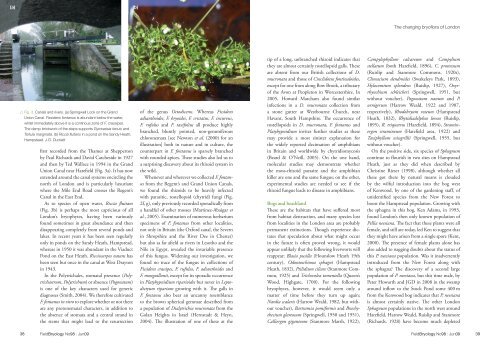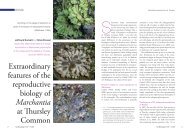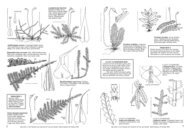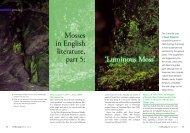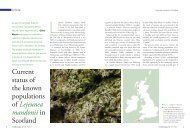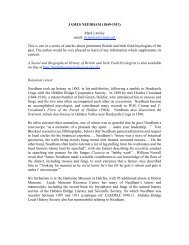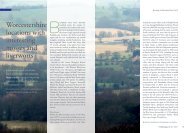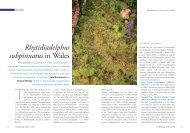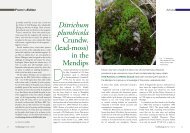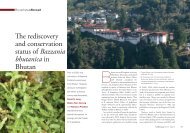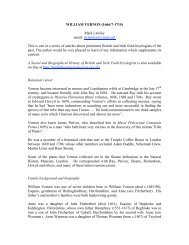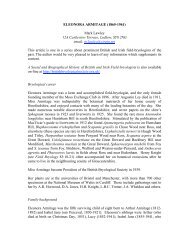London's changing bryophyte flora
London's changing bryophyte flora
London's changing bryophyte flora
You also want an ePaper? Increase the reach of your titles
YUMPU automatically turns print PDFs into web optimized ePapers that Google loves.
(a) (b)<br />
n Fig. 3. Canals and rivers. (a) Springwell Lock on the Grand<br />
Union Canal. Fissidens fontanus is abundant below the water,<br />
whilst immediately above it is a continous zone of F. crassipes.<br />
The damp brickwork of the steps supports Gyroweisia tenuis and<br />
Tortula marginata. (b) Riccia fluitans in a pond on the Sandy Heath,<br />
Hampstead. J.G. Duckett<br />
first recorded from the Thames at Shepperton<br />
by Paul Richards and David Catcheside in 1927<br />
and then by Ted Wallace in 1994 in the Grand<br />
Union Canal near Harefield (Fig. 3a). It has now<br />
extended around the canal systems encircling the<br />
north of London and is particularly luxuriant<br />
where the Mile End Road crosses the Regent’s<br />
Canal in the East End.<br />
As to species of open water, Riccia fluitans<br />
(Fig. 3b) is perhaps the most capricious of all<br />
London’s <strong>bryophyte</strong>s, having been variously<br />
found sometimes in great abundance and then<br />
disappearing completely from several ponds and<br />
lakes. In recent years it has been seen regularly<br />
only in ponds on the Sandy Heath, Hampstead,<br />
whereas in 1950 it was abundant in the Viaduct<br />
Pond on the East Heath. Ricciocarpos natans has<br />
been seen but once in the canal at West Drayton<br />
in 1943.<br />
In the Polytrichales, stomatal presence (Polytrichastrum,<br />
Polytrichum) or absence (Pogonatum)<br />
is one of the key characters used for generic<br />
diagnoses (Smith, 2004). We therefore cultivated<br />
F. fontanus in vitro to explore whether or not there<br />
are any protonematal characters, in addition to<br />
the absence of stomata and a central strand in<br />
the stems that might lead to the resurrection<br />
of the genus Octodiceros. Whereas Fissidens<br />
adianthoides, F. bryoides, F. cristatus, F. incurvus,<br />
F. rufulus and F. taxifolius all produce highly<br />
branched, bluntly pointed, non-gemmiferous<br />
chloronemata [see Newton et al. (2000) for an<br />
illustration] both in nature and in culture, the<br />
counterpart in F. fontanus is sparsely branched<br />
with rounded apices. These studies also led us to<br />
a surprising discovery about its rhizoid system in<br />
the wild.<br />
Whenever and wherever we collected F. fontanus<br />
from the Regent’s and Grand Union Canals,<br />
we found the rhizoids to be heavily infected<br />
with parasitic, rostellopsid (chytrid) fungi (Fig.<br />
2f, g), only previously recorded sporadically from<br />
a handful of other mosses (Martinez-Abaigar et<br />
al., 2005). Examination of numerous herbarium<br />
specimens of F. fontanus from other localities,<br />
not only in Britain (the Oxford canal, the Severn<br />
in Shropshire and the River Dee in Chester)<br />
but also as far afield as rivers in Lesotho and the<br />
Nile in Egypt, revealed the invariable presence<br />
of this fungus. Widening our investigation, we<br />
found no trace of the fungus in collections of<br />
Fissidens crassipes, F. rufulus, F. adianthoides and<br />
F. monguillonii, except for its sporadic occurrence<br />
in Platyhypnidium riparioides but never in Leptodictyum<br />
riparium growing with it. The galls in<br />
F. fontanus also bear an uncanny resemblance<br />
to the brown spherical gemmae described from<br />
a population of Dialytrichia mucronata from the<br />
Golan Heights in Israel (Hernstadt & Heyn,<br />
2004). The illustration of one of these at the<br />
tip of a long, unbranched rhizoid indicates that<br />
they are almost certainly rostellopsid galls. These<br />
are absent from our British collections of D.<br />
mucronata and those of Cinclidotus fontinaloides,<br />
except for one from along Bow Brook, a tributary<br />
of the Avon at Peopleton in Worcestershire. In<br />
2005, Howard Matcham also found similar<br />
infections in a D. mucronata collection from<br />
a stone gutter at Westbourne Church, near<br />
Havant, South Hampshire. The occurrence of<br />
rostellopsids in D. mucronata, F. fontanus and<br />
Platyhypnidium invites further studies as these<br />
may provide a most sinister explanation for<br />
the widely reported decimation of amphibians<br />
in Britain and worldwide by chytridiomycosis<br />
(Beard & O’Neill, 2005). On the one hand,<br />
molecular studies may demonstrate whether<br />
the moss-rhizoid parasite and the amphibian<br />
killer are one and the same fungus; on the other,<br />
experimental studies are needed to see if the<br />
rhizoid fungus leads to disease in amphibians.<br />
Bogs and heathland<br />
These are the habitats that have suffered most<br />
from habitat destruction, and many species lost<br />
from localities in the London area are probably<br />
permanent extinctions. Though experience dictates<br />
that speculation about what might occur<br />
in the future is often proved wrong, it would<br />
appear unlikely that the following liverworts will<br />
reappear; Blasia pusilla (Hounslow Heath 19th<br />
century), Odontoschisma sphagni (Hampstead<br />
Heath, 1832), Ptilidium ciliare (Stanmore Common,<br />
1925) and Trichocolea tomentella (Queen’s<br />
Wood, Highgate, 1700). For the following<br />
<strong>bryophyte</strong>s, however, it would seem only a<br />
matter of time before they turn up again;<br />
Nardia scalaris (Harrow Weald, 1982, but without<br />
voucher), Bartramia pomiformis and Brachythecium<br />
glareosum (Springwell, 1950 and 1951),<br />
Calliergon giganteum (Stanmore Marsh, 1922),<br />
The <strong>changing</strong> bryo<strong>flora</strong> of London<br />
Campylophyllum calcareum and Campylium<br />
stellatum (both Harefield, 1896), C. protensum<br />
(Ruislip and Stanmore Commons, 1920s),<br />
Climacium dendroides (Swakeleys Park, 1893),<br />
Hylocomium splendens (Ruislip, 1927), Oxyrrhynchium<br />
schleicheri (Springwell, 1951, but<br />
without voucher), Pogonatum nanum and P.<br />
urnigerum (Harrow Weald, 1922 and 1907,<br />
respectively), Rhodobryum roseum (Hampstead<br />
Heath, 1832), Rhytidiadelphus loreus (Ruislip,<br />
1895), R. triquetrus (Harefield, 1894), Straminergon<br />
stramineum (Harefield area, 1922) and<br />
Taxiphyllum wissgrillii (Springwell, 1955, but<br />
without voucher).<br />
On the positive side, six species of Sphagnum<br />
continue to flourish in two sites on Hampstead<br />
Heath, just as they did when described by<br />
Christine Rieser (1998), although whether all<br />
these got there by natural means is clouded<br />
by the wilful introduction into the bog west<br />
of Kenwood, by one of the gardening staff, of<br />
unidentified species from the New Forest to<br />
boost the Hampstead population. Growing with<br />
the sphagna in this bog, Ken Adams, in 1993,<br />
found London’s then only known population of<br />
Pellia neesiana. The fact that these plants were all<br />
female, and still are today, led Ken to suggest that<br />
they might have arisen from a single spore (Kent,<br />
2000). The presence of female plants alone has<br />
also added to nagging doubts about the status of<br />
this P. neesiana population. Was it inadvertently<br />
introduced from the New Forest along with<br />
the sphagna? The discovery of a second large<br />
population of P. neesiana, but this time male, by<br />
Peter Howarth and JGD in 2008 in the swamp<br />
around inflow to the Stock Pond some 400 m<br />
from the Kenwood bog indicates that P. neesiana<br />
is almost certainly native. The other London<br />
Sphagnum populations in the north west around<br />
Harefield, Harrow Weald, Ruislip and Stanmore<br />
(Richards, 1928) have become much depleted<br />
38 FieldBryology No98 | Jun09 FieldBryology No98 | Jun09 39


